THE FARMS LINES OF BROOKLYN (1874)
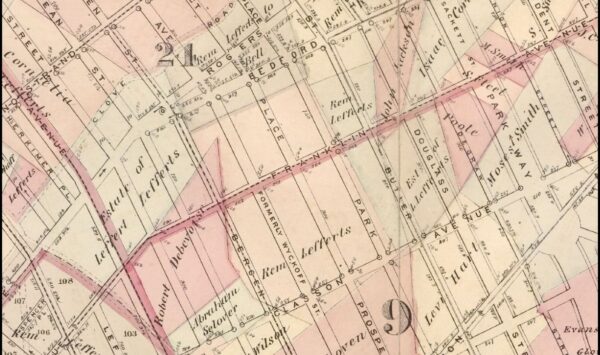
******************************************************************************************************************************** Brownstone Detectives investigates the history of our clients’ homes. The story you are about to read was composed from research conducted in the course of one of those investigations. Do you know the history of YOUR house? ******************************************************************************************************************************** Brooklyn was once one giant farm. At some point, as the farms began to be split up to be sold to developers – those who wanted to build rows of prized brownstones – companies also began to pop up which developed maps showing what types of buildings existed on every “lot” within the city. Although no longer used for fire insurance purposes, they are great tools for those owners wishing to research the histories of their properties. If you own a home in New York City, these maps can help you to determine how old it is, what else had been built in the area when your house was new, and, on some maps, the name of the farmer that had once owned your land. Find yours HERE. Follow @BrownstoneDetec Share ———————————————————————————————————————– The Brownstone Detectives Brownstone Detectives is an historic property research agency. Our mission is to document and save the histories of our clients’ homes. From our research, we produce our celebrated House History Books and House History Reports. Contact us today to begin discovering the history of your home.
THE “WEIRFIELD” HOUSE ON THE HILL (1850)
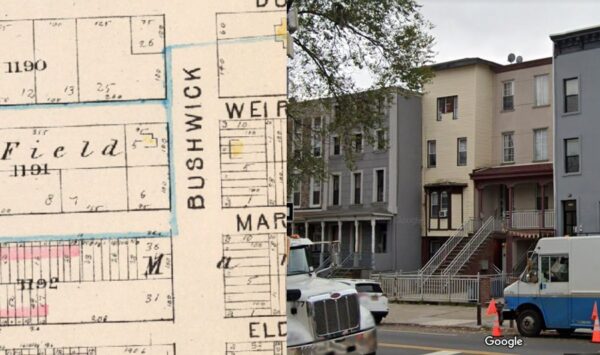
******************************************************************************************************************************** Brownstone Detectives investigates the history of our clients’ homes. The story you are about to read was composed from research conducted in the course of one of those investigations. Do you know the history of YOUR house? ******************************************************************************************************************************** If Bushwick Avenue were a family, it would likely be an entertainingly and curiously dysfunctional clan. It would maybe be something akin to that harmless uncle who comes to Thanksgiving dinner, doesn’t talk about politics, but engages in witty banter and sips a few too many vermouths. Some houses on the avenue present as mindlessly conforming rowhouses — lined up at attention like toy soldiers. Squeezed within some of those rows, however, we sometimes find structures that seem oh-so-slightly out-of-place – as though they were built in – and transported from – another time and galaxy. One such structure is a 172-year-old house that appears as though it should be sitting alone upon a hill with a view to unfolding valleys of pastureland. THE HOUSE ON THE HILL In the mid-1800s, No. 1250 Bushwick Avenue was the only house on the south side of Bushwick Avenue between Weirfield and Margaretta (Halsey) Streets. The house was erected in approximately 1850 and, in its day of glory, stood on a knoll about six feet above street level, flanked on either side by immense maple trees. The grounds sloped gently down to a stone wall, five feet above the grade of the street, which extended along the street frontage from Weirfield street to Margaretta […]
PAINTING THE HUDSON AT No. 75 ST. JAMES PL
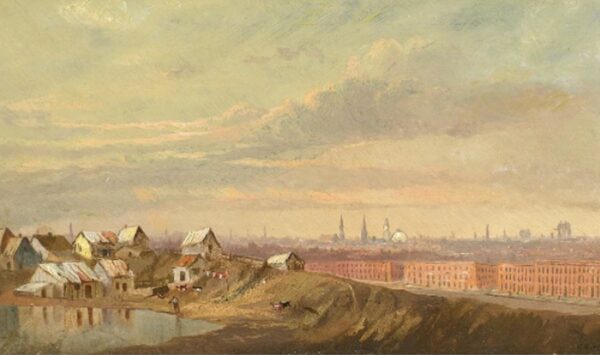
******************************************************************************************************************************** Brownstone Detectives investigates the history of our clients’ homes. The story you are about to read was composed from research conducted in the course of one of those investigations. Do you know the history of YOUR house? ******************************************************************************************************************************** Charles Day Hunt was a talented landscape painter whose work pivoted between the naturalism of the Hudson River School and the expressionism of the Tonalists. Born in Detroit, Michigan, in 1840, he eventually settled in Brooklyn, New York, around 1858 and trained under the landscape painters of the day: John F. Kensett and Alexander Wyant. Hunt’s exhibitions of oil and water color works took place from his studio at No. 75 St. James Place in Clinton Hill section of Brooklyn. Hunt’s work seamlessly blends the influences of both of his mentors in an individual style of crisp brilliance and atmospheric moodiness. Beginning in 1866 going through 1886, Hunt exhibited many times at The National Academy of Art & Design and The Brooklyn Academy of Art. He gained prominence as a member of The Black & White Club, which was a private American art association. Hunt died in 1914 in Brooklyn where, in his studio, his funeral was held. The body lay “beside the empty studio chair, pulled up before the easel,” noted the Brooklyn Daily Eagle, “on which was the picture Mr. Hunt had been working on before his seizure; the palette and oil colors were still wet.” Today, his works can be found in private and public collections, including The Brooklyn Museum […]
YOUR BROWNSTONE WAS NOT BUILT IN 1899
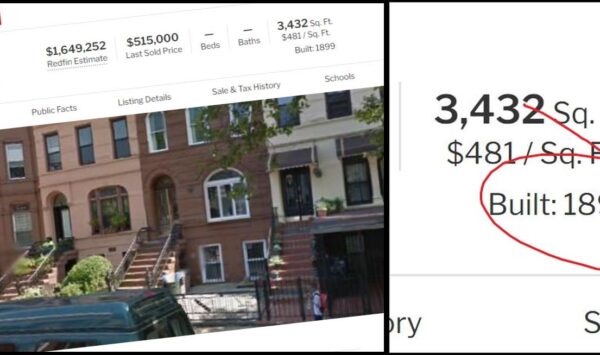
******************************************************************************************************************************** Brownstone Detectives investigates the history of our clients’ homes. The story you are about to read was composed from research conducted in the course of one of those investigations. Do you know the history of YOUR house? ******************************************************************************************************************************** We’ve all “Googled” ourselves, right? But have you ever Googled your house? Most people do this out of curiosity – just to see what might pop up. If you’ve ever done it, though, you were likely greeted with an extensive list of real estate sites that literally entreated you to click their links. Click on one of them and you may be surprised at what you find. Apparently, using their fancy algorithms, these sites can tell you nearly every detail under the sun about your property. These details include: the number of stories your house has, how many units are inside, the legal type of building it is, the district it lies within, its floor plans, the name of its neighborhood, its estimated value, various documents and permits filed, past sales, rental – and the list goes on and on… You may possibly even see images of the exterior of your rowhouse, as well as numerous snapshots of the inside (likely from a previous sale). For the most part you may note that everything – so far as you can tell – is relatively correct. There is, however, one very important piece of information that, on 99% of informational listings (including yours), is dead wrong… “BUILT IN 1899”? Why does nearly […]
HOW YOUR BROWNSTONE LOST ITS SOUL (1915)
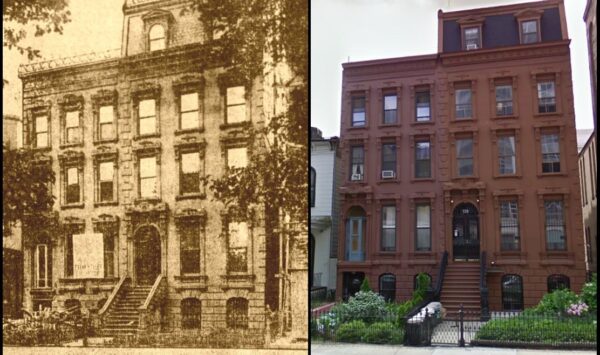
******************************************************************************************************************************** Brownstone Detectives investigates the history of our clients’ homes. The story you are about to read was composed from research conducted in the course of one of those investigations. Do you know the history of YOUR house? ******************************************************************************************************************************** It started just 20 years after construction began on “Brownstone Brooklyn” – our brownstones and townhouses began to lose their “souls.” Constructed in a time when owners needed three and four stories of room for large families, they had, in those times, existed as the epitome of style and class. Now that so much square footage so close to the city center was becoming too dear for so many residents (who did not have families or who needed much less room), builders were beginning to construct large apartment houses that provided all of the necessities of home within a smaller, but more stylish and efficiently laid out, space. Such competition from newer construction caused the formerly beloved brownstone to lose its lucrative “soul.” THE SOLUTION TO ANTIQUITY In 1915, real estate broker Frank Tyler struck upon an idea that turned out to be, in essence, a paradigm change: Take an old inefficient brownstone and turn it into a stylish and updated apartment house. Tyler noticed that “the average three-story and basement dwelling of old-fashioned style” had “become a drag on the real estate market.” Because of “great changes that have taken place in construction, and the popularity of apartment house living,” brownstone owners had been experiencing a decline in the rental […]
RISE & FALL OF THE STUYVESANT CLOWN (1895)
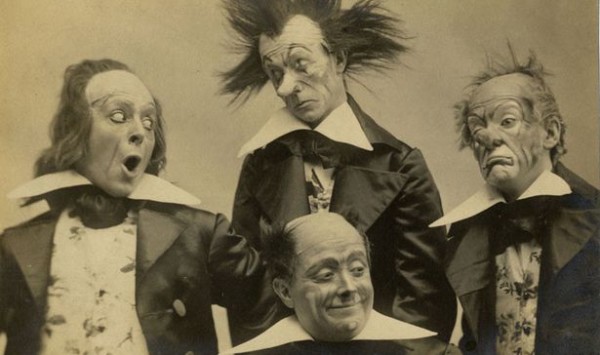
******************************************************************************************************************************* Brownstone Detectives investigates the history of our clients’ homes. The story you are about to read was composed from research conducted in the course of one of those investigations. Do you know the history of YOUR house? ******************************************************************************************************************************* Back in the early 1890s, in Stuyvesant Heights, there were clowns everywhere. Roaming and squeezing their little horns, making sad, droopy faces, and generally miming mischief. And everyone came to see them at Halsey Street and Saratoga where they paid a nickel a person to get in. Life for the clowns existed there for at least 20 years, until one day it all came to a halt. The developers had arrived and were threatening the home of the clown, threatening his very existence. BROOKLYN EXPANDS TO BUSHWICK By the mid-1890s, three blocks in the furthest reaches of the Eastern District’s Stuyvesant Heights had surprisingly remained untouched by speculative progress. While feverish land purchasing and selling had gone on all around this valuable real estate for the previous ten or so years, these dusty plots of land would continue to sit like the vestiges of the past that they were – unused farm land. Eventually, though, this land would be put to use by a bunch of clowns – the lots would begin, in 1891, to be referred to as the “circus grounds,” as traveling circuses and shows would begin annually to rent the land for their high profile extravaganzas. But the reign of the Stuyvesant Clown would be relatively short as, […]
SUNSETTING ON A BED-STUY BOULEVARD (1909)
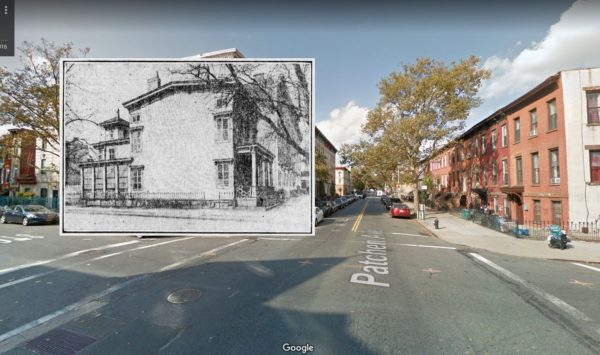
******************************************************************************************************************************** Brownstone Detectives investigates the history of our clients’ homes. The story you are about to read was composed from research conducted in the course of one of those investigations. Do you know the history of YOUR house? ******************************************************************************************************************************** In 1909, a landmark was about to be destroyed. It was quite common, though, at the time for owners to tear down the antiquated wood-frame mansions that dotted Brooklyn’s lamdscape. Since the new brownstone houses had become all the rage in the 1880s, these tinder “firetraps” had become redundant, difficult to sell, and simply unstylish to live in. By the late 19th century, they were being sold, in many cases, for the value of their land as building lots. And with the demise of these historical artifacts, went some truly beautiful examples of mid-19th century architecture, few of which remain with us to this day. THE DE MILLE HOUSE The De Mille house was built around the middle of the 19th century for the family of that name, “and it has been a landmark in that region since the days when it was surrounded by open fields.” Yes, even Bedford-Stuyvesant – today chockablock with brownstone and masonry homes – was once – even before the advent of wood-frame homes – forested land alongside open virgin fields. As a matter of fact, the corner of Quincy and Patchen, in the 1850s, was little more than hills, dales, dirt lanes, and the vague promise of a future suburban city. “Broadway, which is nearby, […]
SPRING BRINGS THE BEAN SHOOTERS (1863)
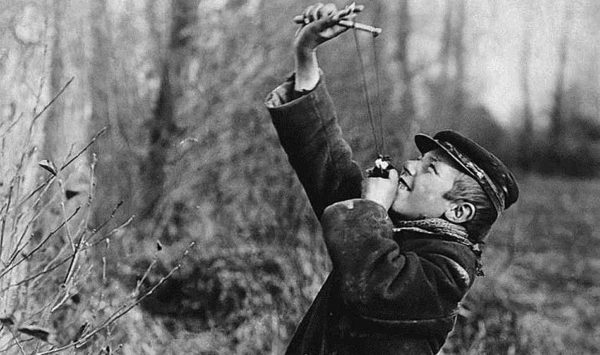
******************************************************************************************************************************** Brownstone Detectives investigates the history of our clients’ homes. The story you are about to read was composed from research conducted in the course of one of those investigations. Do you know the history of YOUR house? ******************************************************************************************************************************** There were a LOT of bad little boys in Brooklyn in the 19th century. Sifting through old issues of the Brooklyn Daily Eagle, the Standard Union, and other Brooklyn papers, I come across evidence of this on a daily basis. Of all the crimes that I see having been committed, one of the most common – and interesting – is the work of the “bean shooters.” When I was a kid I had a bean-shooter myself – and I did the same thing. There were a lot of broken window panes in my neighborhood – some I was found guilty of breaking – and most others of which I got away scot free of any blame whatsoever. (There was always the suspicion, though, that I was the culprit.) But I digress. Let’s rewind, though – further back to the mid- to late-1800s, and take a look at the work of my fierce little boy predecessors. BEAN-SHOOTING IN 19TH CENTURY BROOKLYN While sling shots (or often called “slung shots”) were a constant presence in the hands of gang members and criminals (they were outlawed by the New York State Legislature in 1849), it seems that the use of such a device by boys, with any degree of consistency, did not come until […]
THE “IMPOSING” VIEW FROM OCEAN HILL (1848)
******************************************************************************************************************************** Brownstone Detectives investigates the history of our clients’ homes. The story you are about to read was composed from research conducted in the course of one of those investigations. Do you know the history of YOUR house? ******************************************************************************************************************************** Before there was Ocean Hill—the Bedford-Stuyvesant neighborhood—there was Ocean Hill—the section of Green-Wood Cemetery. Whether one influenced the other is lost to the ages. What is clear, however, is that both locations got their names from a geographical point from which a body of water could clearly be viewed. “At this point, now known as Ocean Hill,” described a contributor (whose pen-name, revealingly, was Investment) in an edition of the Brooklyn Daily Eagle published just a few years before the Civil War began, “we have reached the highest point on the avenue (Fulton Street) and the most commanding elevation of ground in the city; and which, for grandeur, beauty and variety of its scenery, cannot be surpassed. “The ocean view,” Investment continued, “is especially grand and imposing.” Investment, whose contribution to the paper existed as a thinly veiled promotional piece for Brooklyn, was describing the “advance in the value of Brooklyn real estate.” From Fulton Ferry he advanced down Fulton Avenue to “gather such information as will enable the public to form an intelligent estimate as to the present and prospective value of property on and near this great thoroughfare.” “At this point Fulton avenue is distant but a few hundred feet from Atlantic avenue on the south, and Broadway on […]
THE SEVEN SISTERS OF LINCOLN PLACE (1906)
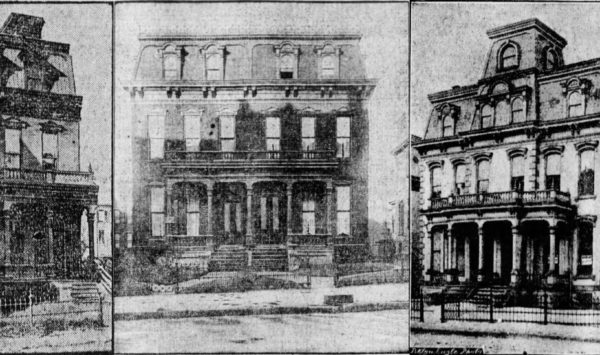
******************************************************************************************************************************** Brownstone Detectives investigates the history of our clients’ homes. The story you are about to read was composed from research conducted in the course of one of those investigations. Do you know the history of YOUR house? ******************************************************************************************************************************** If the Big Bad Wolf had had anything to do with it, he would have always voted for the predictability of a good detached wood-frame villa. It had gotten him far in his day and, what’s more, it had gotten him fed. But it wasn’t the Three Little Pigs’ hairy nemesis that was making housing decisions in Park Slope, Brooklyn around the turn of the last century. Rather, it was the Pigs, themselves, who wanted more modern, sturdier, up-to-date brick and masonry structures. THE DEATH OF VILLAS In early 20th century Brooklyn, a combination of home buyers’ indicators was guiding downward the valuation of older Victorian-era properties. First of all, impacting the long-term downward trajectory, there were the laws promoting fire zones that prevented structures built with wood frames from being constructed going forward. There was also their susceptibility to fire (which prompted these fire zones in the first place). And there was their age – a large number of free-standing villas still around in Brooklyn at the time were at least 25 years old – most others were many years older that that. Most visible, however, were the tastes of the early 20th century home buyers which leaned heavily in the direction of sturdy masonry buildings. The variable, however, which […]